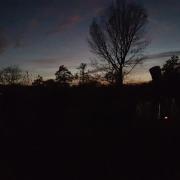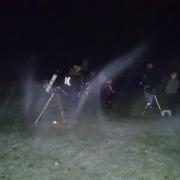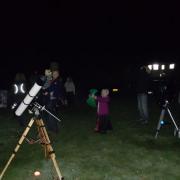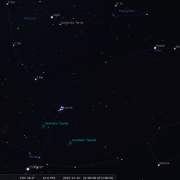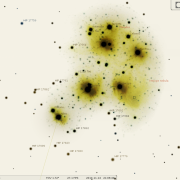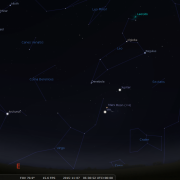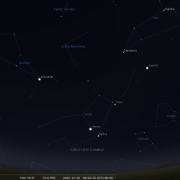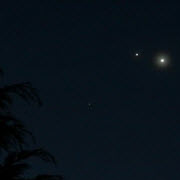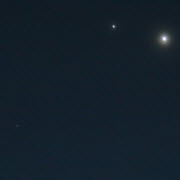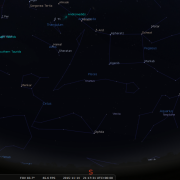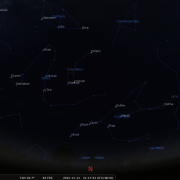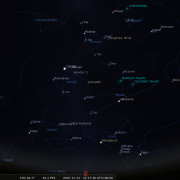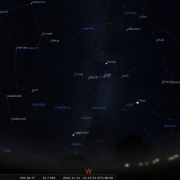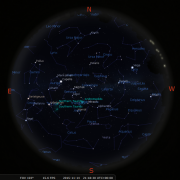Welcome to the WDAS monthly newsletter for November 2015: a digest of the month's latest contributions to our website. Below you'll find Society News, Sky Notes and In-Focus articles printed in full. There's also future events, and trailers for other articles which appear in full on the website - just a click away!
On the website you'll also be able to comment on articles, and if you'd like to play an editorial role in creating new content, just let us know!
Quick Summary for November:
- We'll be building Comets at the WDAS Monthly Meeting on Tue 3rd November. It should be a fun event - come if you can!
- Leeds Astromeet on Sat 7th November.
Society News
We are obviously situated well away from any black holes, as time has flown this year and already we are approaching the Leeds Astromeet, which is on Saturday 7th Nov. The venue as usual is the Clothworkers Hall and Foyer, Leeds University. Doors open at 9.00am with talks from 10.00am to approx 16.30h. Traders and some astro-organisations will be present.
Ticket cost: £10 at the door, reduced to £5 for under-16s and full time students on presentation of a valid student card.
As of late September confirmed speakers are
 |
Astronomy at High-Speed: delving the depths of white dwarfs, neutron stars and black-holes Prof Tom Marsh (Warwick University) |
 |
What's the (Dark) Matter? Dr Richard Massey (Durham University) |
 |
Developments in Radio Astronomy Dr Melvin Hoare (Leeds University) |
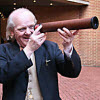 |
The Life of Sir Patrick Moore Dr Alan Chapman (Oxford University) |
Probably two cars will be traveling over to Leeds, meeting at the top of College drive and departing at 08:00h on the 7th November. Please be prompt and reserve a place now.
Link: Astromeet 2015 Website
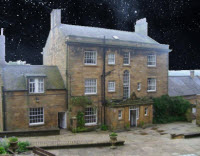 Keith and Mark hosted a star party for pupils and staff at Fylinghall School on Oct 2nd.
Keith and Mark hosted a star party for pupils and staff at Fylinghall School on Oct 2nd.
Once again the weather played ball and although some wispy cloud developed, it soon dispersed allowing fine views of various objects through the LX 200 and Keith’s reflector. Intended to last a couple of hours, the event went on until after 10pm, with a host of questions to answer.
The pupils certainly enjoyed the evening and from the reaction of the staff, more astro-related material may in future pop up in science lessons!
Mark and Keith travelled over to Westerdale again on Oct 9th and were joined by John Randles to host an event at the village hall for pupils, parents and staff of Pathways School (Grangetown, Middlesbrough) along with children belonging to staff. The event was requested by event Emma Shaw, a science teacher at the school whose parents live in Westerdale, and arose after Emma had heard about the success of our Westerdale star party in September.
The Pathways children all have a range of difficulties, based around social and emotional problems, but all are very enthused about science. Emma had arranged to bring the school iPads with planets app on, together with some light supper and party bags for the children (and Adults)
Rather annoyingly pesky cloud refused to clear and only limited observations were possible. Indoors, Mark gave a presentation and got the children to help out with the scale solar system demonstration. It has to be said the pupils were well behaved, asked good questions and showed keen interest in all the activities, better than some groups we have given presentations to. The only negative of the evening was the disappointment of not being able to show the objects we wanted to. Still, all enjoyed the night and perhaps something similar will organised for next year.
On Halloween itself, as Whitby was overflowing with Goth Weekend revellers; Mark, Warren, Keith and Andi headed out with scopes to Danby, where the North Yorkshire Moors National Park had laid on a family Halloween event.
Children and parents were entertained by the wonders of the night sky, a WDAS laser extravaganza. Warren and Andi also tried out night vision omnioculars, courtesy of Grover Optics.
Witching night to be sure: among his photos, Warren captured a ghostly fog which briefly descended, perhaps signalling some spectral intention? No Photoshop work on the middle image - honest!
In-Focus
Ah, mid autumn, the ‘witching season’, a time in the year most associated with ghoulish revelry, the tragic and the macabre. Not surprisingly the autumnal night sky plays host to a reflection of such ‘unearthly goings on’, manifest as tales associated with the stars and constellations.
So, are you sitting comfortably? Good. Let us begin with one of the oldest and most intricate tales associated with the heavens, one that incorporates a number of important and ancient constellations currently located in the night sky.
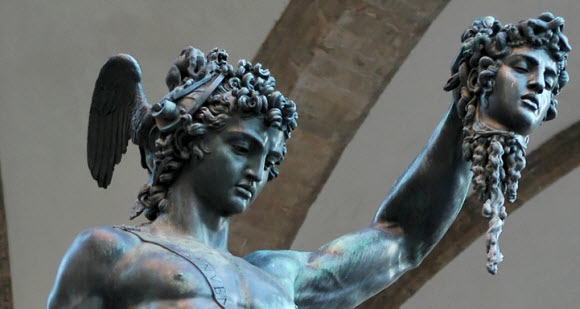
Perseus slew Gorgon Medusa, and with her head defeated the Craken Sea Monster who was turned to stone.
As one of the great heroes of Greek mythology, stories associated with Perseus can be traced as far back as the 5th century BC. Perseus was the son of Zeus and Danae and great grandfather of Heracles. Of all Perseus’s deeds, his the quest to kill the Gorgon is best known. Perseus was tasked to do this by King Polydectes, who for his own ends wanted Perseus out of the way. This particular Gorgon – Medusa, was a hideous creature with snakes for hair, a face covered with dragon scales and sporting tusks, and whose glance could turn the unfortunate to stone. Unbeknown to the Polydectes, to aid in his quest the gods furnished Perseus with various items, including a polished bronze shield, a sword of diamond, a helmet of darkness and winged sandals. Pretty useful items! Perseus defeated Medusa by catching her reflection in his polished shield, before decapitating her with his sword. According to one legend, from the blood soaked ground sprang forth the great winged horse Pegasus and the warrior Chrysaor.
En route home, Perseus spied far below a beautiful young woman chained to a rocky promontory. Churning toward her was a huge monster. The woman; Princess Andromeda, was in this predicament through no fault of her own. Daughter of Queen Cassiopeia and King Cepheus, Cassiopeia had boasted that the beauty of Andromeda surpassed that of the sea nymphs, enraging the sea god, Poseidon, who sent a sea monster, the Craken to ravage the coast of King Cepheus’ kingdom. According to the oracle the only way to appease Poseidon was by the sacrifice of Andromeda. So, it was that in the nick of time, Perseus tricked the Craken into looking directly at the severed head of Medusa, instantly turning the monster to stone. Hero and heroine were duly wed. Later Perseus took his revenge on King Polydectes by turning him into a pillar of stone. Athene then took the head of Medusa and set it in the middle of her shield. The whole cast of characters in this, dramatis personae, are all to be found arcing across the autumn night sky.

Perseus later used Medusa's Head to turn turn the treacherous King Polydactes to stone after the King had tried to kill him.
The constellation of Perseus itself partly lies within the Milky Way and contains some fine deep sky objects, in particular the Perseus double cluster, which on star charts marks the hero’s sword. It is regarded by many amateur astronomers as one of the loveliest sights visible in smaller instruments, a stellar jewel box! The cluster lies midway between Perseus and Cassiopeia.
Perseus’s chief star is called Mirphak (or Mirfak), however, Beta Persei, or Algol is of far more interest. Throughout early antiquity it was noted with much consternation that this star appeared to ‘wink’ every third day. The star became known as ‘the demon’s head’ from the Arabic word ra’s al-ghul (رأس الغول). It is doubtful if the Arabs knew of the Perseus–Medusa legend, but they had an equally terrible one of their own, a Ghul, a nightmare that haunted and ultimately destroyed men. This star was certainly viewed with great suspicion and as such considered dangerous or unlucky. Older star charts have Algol marking the decapitated head of Medusa - the ‘demons head’. Science has long since uncovered the truth behind Algol and we now know it to be a eclipsing binary consisting of two stars orbiting close together, the fainter component passing directly in front of the primary every 2 days; 21 hours, the eclipse process or ‘wink’ lasting almost ten hours before the eclipse ends, thereafter the ‘demon star’ returns to normal.
To the lower right of Perseus a crooked line of 3 stars denote Aries the ram, the tale of which is a prequel to another well known legend. The initial story relates to the king of Thebes, who was tricked by his scheming second wife into sacrificing the children of his first marriage. Zeus, who was much troubled by this, asked Hermes to rescue the children- Phrixus and Hellas. Hermes sent a flying ram on which they escaped on the night of their sacrifice. Tragically en-route to safety, Hellas - the girl, fell from the ram and drowned in the place that is today known as the Hellespont near Greece. After safely landing Phrixus sacrificed the ram, whereupon its fleece turned to gold, possessing the power to heal anyone covered by it. It is this very same fleece, hung in the sacred grove of Colchis and guarded by a terrible serpent that was forcibly removed after many adventures by Jason and his Argonauts.
Let us turn our gaze now towards the Pleiades, or ‘Seven Sisters’, regarded as the loveliest open star cluster in the entire heavens and certainly one of the most youthful by stellar standards, around 100 million years old. To the casual glance the Pleiades appear as beads of dew on a frosty web. Keen sighted observers can make out more than seven stars with the naked eye, although most people see five or six. Binoculars, or very low telescopic magnifications reveal dozens of stars and the entire cluster contains over 300 members approximately 380 light years away.
Revered throughout antiquity, in Greek mythology the Pleiades were the seven daughters of Atlas and the Oceanid Pleione, after whom they are named. In one tale Orion pursued the sisters for seven years after trying to ravish them and their mother. Zeus immortalized the chase by placing the Pleiades in the heavens. However in another tale Zeus himself seduced three of the sisters. No morals at all, these Gods!
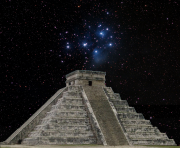
Mayan Pyramid of
Consciousness (illustrated
with Pleiades backdrop)
Of course these legends were not real events, but ancient Aztec and Mayan traditions tell of all too real and gruesome rituals associated with the Pleiades. Then, the midnight culmination of the star cluster was an event of ominous significance, especially so every 52 years when time lines of separately used calendars converged. Believing the world would end at such times, temple steps would run red with the blood of virgins, sacrificed in order to postpone the approaching apocalypse.
Travel to Mexico today and many of the sacred ‘step’ pyramids have their west face orientated to the setting position of the Pleiades. Even as late as the 13th century a sinister influence was first attributed to the Pleiades, when the midnight culmination became the traditional date of the fearsome Witches' Sabbath or Black Sabbat, a night of unholy revelry, a date that preserves the memory of ancient druids' rites, observed today as All Hallows eve – Halloween.
Clear skies – and don’t have nightmares!
Sky Notes
In this month's Sky Notes:
Planetary Skylights


 November commences where October left off, with all of the planetary action occurring in the dawn Eastern sky. Look for the close encounter of Mars and Venus, nestling up alongside each other from the 1st to the 4th. Venus is by far the brightest object in the dawn sky and exhibits a half phase when viewed through a telescope. Mars will appear as a fairly conspicuous ‘orange star’, and although will exhibit a tiny disk when viewed through a telescope, little detail will be visible as yet. The waning crescent Moon joins them on the 7th forming a triangle with Mars and Venus. As the month progresses watch as Venus gradually drops back toward the east horizon.
November commences where October left off, with all of the planetary action occurring in the dawn Eastern sky. Look for the close encounter of Mars and Venus, nestling up alongside each other from the 1st to the 4th. Venus is by far the brightest object in the dawn sky and exhibits a half phase when viewed through a telescope. Mars will appear as a fairly conspicuous ‘orange star’, and although will exhibit a tiny disk when viewed through a telescope, little detail will be visible as yet. The waning crescent Moon joins them on the 7th forming a triangle with Mars and Venus. As the month progresses watch as Venus gradually drops back toward the east horizon.
 Rising in the wee small hours, conspicuous Jupiter resides upper left of Mars and Venus. At the end of last month Jupiter was involved in a spectacular conjunction with Mars and Venus, but already clear blue sky exists between them. Jupiter is a fine telescopic object and unlike Venus has plenty of detail on show. Look for the bands and belts across the disk, the great red spot, which appears quite pale and the attendant Galilean moons next to Jupiter. The Moon lies nearby Jupiter on the 6th By the month’s end Jupiter is rising shortly after midnight.
Rising in the wee small hours, conspicuous Jupiter resides upper left of Mars and Venus. At the end of last month Jupiter was involved in a spectacular conjunction with Mars and Venus, but already clear blue sky exists between them. Jupiter is a fine telescopic object and unlike Venus has plenty of detail on show. Look for the bands and belts across the disk, the great red spot, which appears quite pale and the attendant Galilean moons next to Jupiter. The Moon lies nearby Jupiter on the 6th By the month’s end Jupiter is rising shortly after midnight.

 With Saturn having departed the evening sky, Uranus and Neptune are the only realistic 'evening planets' visible to optical aid. At magnitude 6, binoculars will show Uranus, however only a telescope will reveal its tiny disk. It resides around 1 degree below epsilon Pisces. At almost mag 8 Neptune resides in Aquarius between the two naked eye stars of sigma and lambda Aquarii.
With Saturn having departed the evening sky, Uranus and Neptune are the only realistic 'evening planets' visible to optical aid. At magnitude 6, binoculars will show Uranus, however only a telescope will reveal its tiny disk. It resides around 1 degree below epsilon Pisces. At almost mag 8 Neptune resides in Aquarius between the two naked eye stars of sigma and lambda Aquarii.
Meteor Activity

The Leonids are active from Nov 15-20, peaking this year in the early morning hours of Nov 18th. ZHR’s are expected to be normal, ie around 20 per hour, so an observer may expect to view around 7-12. The Leonids are of course famous for their 33yr (or so) periodic outbursts. This coincides with the orbital period of the showers parent comet - Tempel Tuttle. The next major outburst is not expected until around 2031 at the earliest.
Keep an eye out for a few meteors on the night of Nov 4/5th when the South Taurid meteor shower reaches a peak, and then again on the night of Nov 11/12 when the North Taurid meteor shower peaks. This is a very long duration shower with a low rate of around 5 meteors per hour. The peak does not increase a great deal from this, however both the Taurid showers span over a month so there is a good chance you will spot one or two.
Taurids may well be few, but they tend to produce the odd very bright fireball and therefore well worth keeping an eye out for. The Taurids are an old shower, associated with Comet Encke, which has a period of just 3.3 yrs. Over time dust from this comet has been depleted and spread out over a broad swath of the inner solar system, giving rise to Taurid meteor showers not only on Earth but also on Mars and Venus too!
|
Looking South
Mid November - 21:15h |
Looking North |
|
Looking East
Mid November - 21:15h |
Looking West
Mid November - 21:15h |
|
|
|
|
Overview
Mid November - 21:15h |
|
Additional Image Credits:
- Planets and Comets where not otherwise mentioned: NASA
- Sky Charts: Stellarium Software
A ‘Spooky’ Halloween Visitor
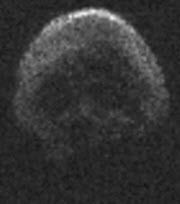
Pumpkin or Skull? Asteroid
2015 TB145 taken on
30-Oct-2015. 7.5m=1 pixel
Image credit: NAIC-Arecibo/NSF
A large asteroid discovered just a few weeks ago will narrowly miss the Earth on Oct 31st – Halloween. Nicknamed “the Great Pumpkin” and “Spooky” but technically known as 2015 TB145, is an estimated 1,300ft (400 meters) wide – 20 times bigger than the meteorite that exploded over Chelyabinsk in 2013. NASA has estimated that it will come closer than any object of its size in the next 20 years.
TB145 will flyby Earth at around 22 miles per second (78,300mph), approximately 300,000 miles (483,000km) from our planet, slightly farther than the moon.
The asteroid will make its closest approach on 31 October at about 5.05pm GMT.
TB145 has an unusually oblong orbit, in an area searched less often than the flat-disc plane on which the solar system is arranged. It last passed by in 1975, when the Earth was at a different place in its orbit around the sun and Nasa’s surveys of the sky were far less comprehensive. In the sky ‘spooky’ is expected to be fairly faint, but can turn to the internet for live telescope views provided by the Virtual Telescope Project.
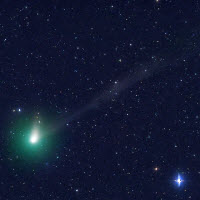
Oort Cloud Comet C/2013
US10 Catalina. Closest to
the Sun on 15-Nov-2015
Comet Catalina was discovered on 31 October 2013 by the Catalina Sky Survey with their 0.68 meter Schmidt-Cassegrain telescope.
The comet has an estimated orbital period of several million years. The comet will reach perihelion on 15 November 2015 at a distance of 0.82 AU.
Through August and September the comet has been around 7th Magnitude but may reach Magnitude 4 or 5 at the end of November and may be visible in the dawn sky.
At perihelion, it will have a velocity of 46.4 km/s (104,000 mph) with respect to the Sun. That's slightly greater than the Sun's escape velocity at that distance, which means this is its last or only visit to the sun: it's on an ejection trajectory.
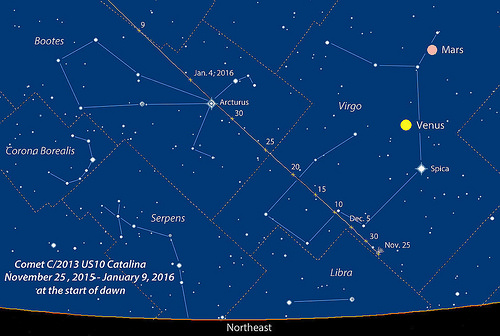
Image Credit: Chris Marriott's SkyMap software
Events
 Observe the night sky with us at the Bruce Observatory, Whitby School
Observe the night sky with us at the Bruce Observatory, Whitby School
Observing Nights are held weather permitting: check for a relatively clear sky before leaving home. If in doubt, Mark can be reached on 07886069339
Please note the college drive gate is now operated via a electronic key code - so anyone wishing to attend must be at the car park at the top of the drive by 19:00hrs - unless an arrival time has been arranged with Mark/Keith.
 Whitby School - Room H1.
Whitby School - Room H1.
In Members' monthly meetings we usually take a tour of the night sky for the coming month using the Planetarium program. Have talks and presentations on various topics of astronomy/space etc, and discuss future events etc. New members welcome.
 Observe the night sky with us at the Bruce Observatory, Whitby School
Observe the night sky with us at the Bruce Observatory, Whitby School
Observing Nights are held weather permitting: check for a relatively clear sky before leaving home. If in doubt, Mark can be reached on 07886069339
Please note the college drive gate is now operated via a electronic key code - so anyone wishing to attend must be at the car park at the top of the drive by 19:00hrs - unless an arrival time has been arranged with Mark/Keith.
 Observe the night sky with us at the Bruce Observatory, Whitby School
Observe the night sky with us at the Bruce Observatory, Whitby School
Observing Nights are held weather permitting: check for a relatively clear sky before leaving home. If in doubt, Mark can be reached on 07886069339
Please note the college drive gate is now operated via a electronic key code - so anyone wishing to attend must be at the car park at the top of the drive by 19:00hrs - unless an arrival time has been arranged with Mark/Keith.
 Observe the night sky with us at the Bruce Observatory, Whitby School
Observe the night sky with us at the Bruce Observatory, Whitby School
Observing Nights are held weather permitting: check for a relatively clear sky before leaving home. If in doubt, Mark can be reached on 07886069339
Please note the college drive gate is now operated via a electronic key code - so anyone wishing to attend must be at the car park at the top of the drive by 19:00hrs - unless an arrival time has been arranged with Mark/Keith.
 Whitby School - Room H1.
Whitby School - Room H1.
In Members' monthly meetings we usually take a tour of the night sky for the coming month using the Planetarium program. Have talks and presentations on various topics of astronomy/space etc, and discuss future events etc. New members welcome.

